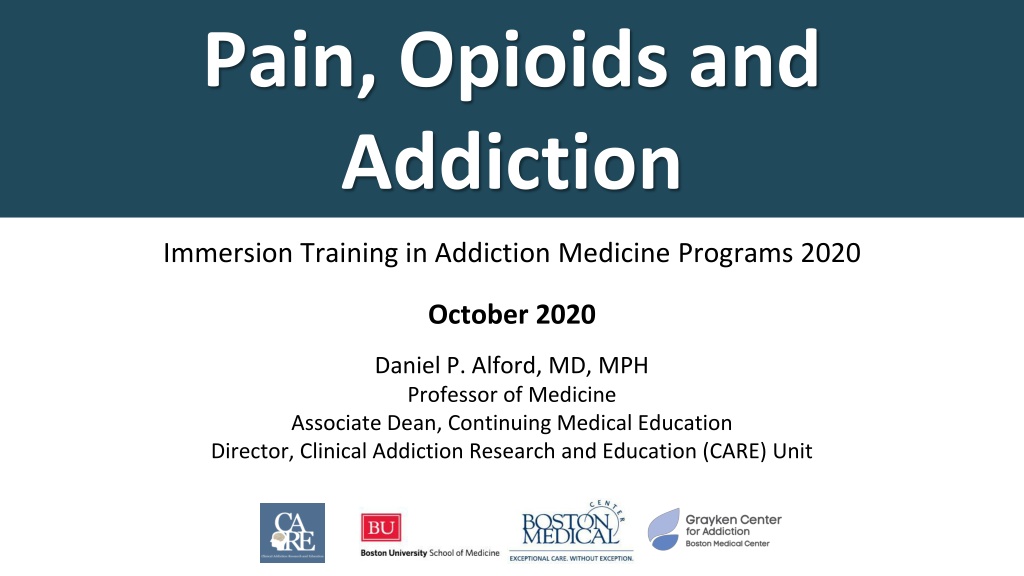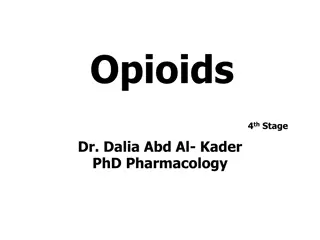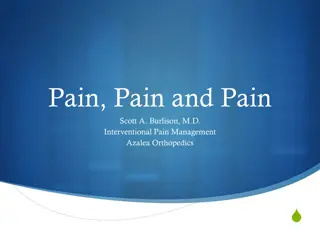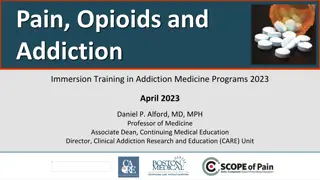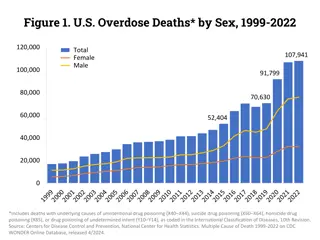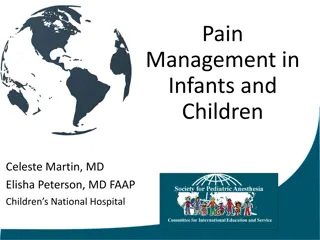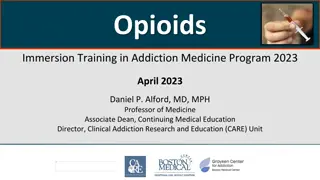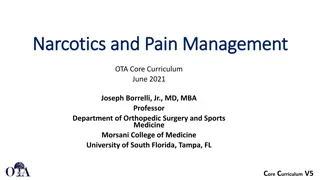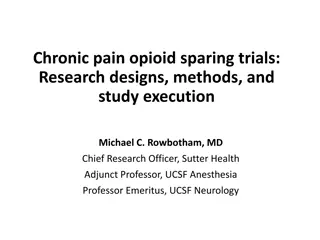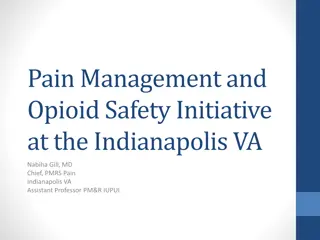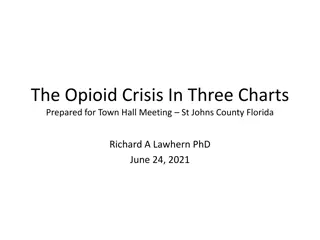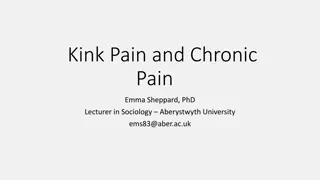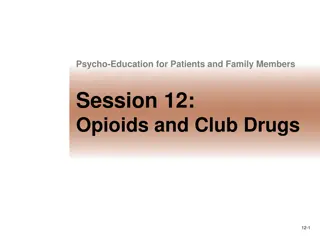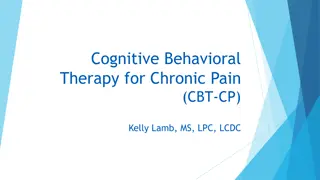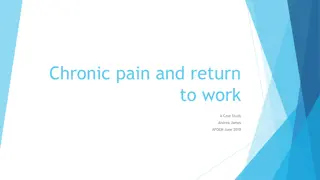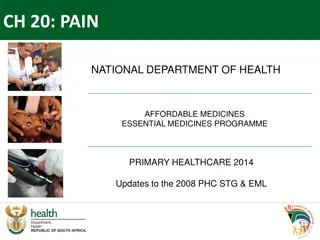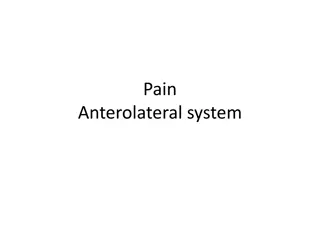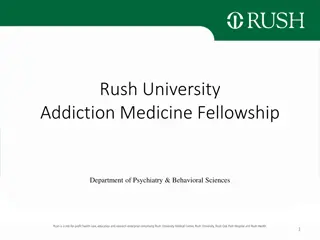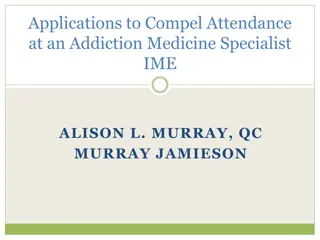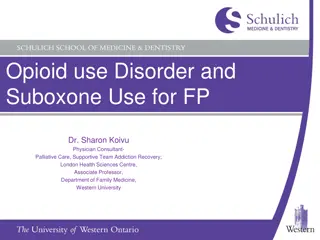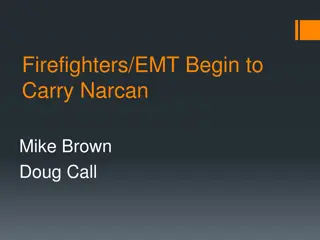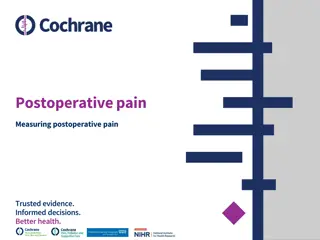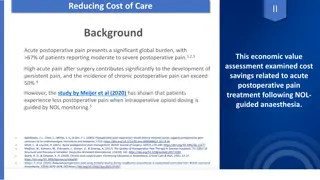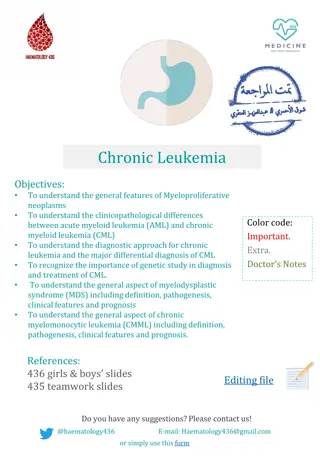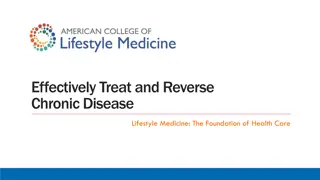Understanding Chronic Pain, Opioids, and Addiction in Medicine
Chronic pain is a complex issue that can impact individuals on various levels. It is important to understand the subjective nature of pain and the barriers to adequate pain care. Opioid analgesics, while effective in managing pain, come with risks such as side effects, addiction, and overdose potential. This training program delves into the intricacies of chronic pain, opioid pharmacology, and the associated risks of opioid use in medical settings.
Download Presentation

Please find below an Image/Link to download the presentation.
The content on the website is provided AS IS for your information and personal use only. It may not be sold, licensed, or shared on other websites without obtaining consent from the author. Download presentation by click this link. If you encounter any issues during the download, it is possible that the publisher has removed the file from their server.
E N D
Presentation Transcript
Pain, Opioids and Addiction Immersion Training in Addiction Medicine Programs 2020 October 2020 Daniel P. Alford, MD, MPH Professor of Medicine Associate Dean, Continuing Medical Education Director, Clinical Addiction Research and Education (CARE) Unit
Chronic Pain is Complex Chronic Pain Can be a disease in itself Acute Pain Life sustaining symptom Maladaptive, pathologic, disorder of the somatosensory pain signaling pathways influenced by genetic and epigenetic factors Adaptive by eliciting motivation to minimize harm and allow healing Associated with higher risk of fatal and nonfatal suicide attempts* * Petrosky E, et al. Ann Intern Med. 2018 Ilgen MA, et al. JAMA Psychiatry. 2013 Tang NK et al. Psychol Med. 2006 Dzau VJ, Pizzo PA. JAMA. 2014 Walk D, Poliak-Tunis M. Med Clin N Am. 2016 Argoff CE, et al. Pain Med. 2009
Chronic Pain in Perspective Chronic pain is common Pain is subjective to the patient and the clinician Pain can t always be visualized Psychiatric co-morbidities are common Significant barriers to adequate pain care Negative attitudes and disparities in pain care Lack of decision support for chronic pain management Financial misalignment favoring use of medications Poor support for team-based care and specialty clinics Many competing priorities in primary care Institute of Medicine. 2011 Relieving Pain in America. Washington DC
Opioid Analgesics Analgesia Turn on descending inhibitory systems Prevent ascending transmission of pain signal Inhibit terminals of C-fibers in the spinal cord Inhibit activation of peripheral nociceptors Variable response (not all patients respond to the same opioid in the same way) >3,000 polymorphisms in the human MOR gene Differences in pharmacokinetics (opioid metabolism) Active the reward pathway Somatosensory cortex Periaqueductal gray area Thalamus Descending pathway Ascending pathways Peripheral nerves Dorsal Horn McCleane G, Smith HS. Med Clin N Am. 2007 Smith HS. Pain Physician. 2008
Opioid Risks Allergies are rare Side effects are common Nausea, sedation, constipation, urinary retention, sweating Respiratory depression sleep apnea Organ toxicities are rare Suppression of hypothalamic-pituitary-gonadal axis Immunosuppression Increased risk of invasive pneumococcal dz and community acquired pneumonia Worsening pain(hyperalgesia in some patients) Addiction (Opioid Use Disorder) Overdose when combined w/ other sedatives and at higher doses Dunn KM et al. Ann Intern Med 2010 Li X et al. Brain Res 2001 Doverty M et al. Pain 2001 Angst MS, Clark JD. Anesthesiology 2006 Wiese AD, et al. Ann Intern Med. 2018
Treatment Gaps Following Opioid Overdose Opioids were dispensed to 91% of patients after a nonfatal overdose n=2848 7% had repeat opioid overdose At 2 years, cumulative incidence of repeated overdose was 17% for patients on high opioid dosages after the index overdose Larochelle MR, et al. Ann Intern Med. 2016
Opioid Prescribing Trends Since 2011 MME decline by 43% 2018 largest MME decline at 17% www.fda.gov, ONDCP 2019
Safer Opioid Prescribing for Chronic Pain
The pain medication conundrum Opinion Undertreating pain, we are admonished it violates the basic ethical principles of medicine. On the other hand, we are lambasted for overprescribing pain medications creating an epidemic of overdose deaths. For patients with chronic pain, especially those with syndromes that don t fit into neat clinical boxes, being judged by doctors to see if they merit medication is humiliating and dispiriting. This type of judgment, with its moral overtones and suspicions, is at odds with the doctor-patient relationship we work to develop. As Mr. W. and I sat there sizing each other up, I could feel our reserves of trust beginning to ebb. I was debating whether his pain was real or if he was trying to snooker me. He was most likely wondering whether I would believe him Danielle Ofri, MD Associate Professor at NYU and a physician at Bellevue Hospital, August 2015
Opioid Efficacy for Chronic Pain Meta-analyses (3-6 m f/u) Opioids vs placebo (high quality studies) Opioids with statistically significant, but small, improvements in pain1,2 and physical functioning.2 RCT3 found opioids not superior to nonopioids for improving musculoskeletal pain- related function over 12 months Two longer term follow-up studies found 44.3% on chronic opioids for chronic pain had at least 50% pain relief 5 Study limitations: 4 Excluded patients already on long-term opioids 89% of eligible patients declined to be enrolled Opioids vs nonopioids (low-mod quality studies) Similar benefits2 1. Meske DS, et al. J Pain Res. 2018 2. Busse JW, et al. JAMA. 2018 3. Krebs EE, et al. JAMA. 2018 4. Webster L. Pain Med. 2019 5. Noble M, et al. Cochrane Syst Rev. 2010
Multidimensional Care for Chronic Pain Restore Function Studies on all pharmacologic and nonpharmacologic treatments for chronic pain are < 12 m, vast majority are < 12 w Exercise CBT/ACT Tx mood/trauma issues Address substances Meditation Manual therapies Orthotics TENS Other modalities (heat, cold, stretch) Psycho- behavioral Physical Tayeb BO, et al. Pain Med. 2016 Cultivate Well-being Reduce Pain SELF CARE Multimodal approaches are more cost-effective than single modality options Medication Procedural Acupuncture Nerve blocks Steroid injections Trigger point injections Stimulators Pumps NSAIDs Anticonvulsants Antidepressants Topical agents Flor H, et al. Pain 1992 Roberts AH, et al. Clin J Pain. 1993 Patrick LE, et al. Spine. 2004 Kamper SJ, et al. Cochrane Review. 2014 Opioids Others Improve Quality of Life
Assessing Benefit PEG scale Krebs EE, et al. J Gen Intern Med. 2009
Problematic Opioid Use Systematic review from 38 studies (26% primary care, 53% pain clinics) Misuse rates: 21% - 29% Misuse: Opioid use contrary to the directed or prescribed pattern of use, regardless of the presence or absence of harm or adverse effects. Addiction rates: 8% - 12% Addiction: Pattern of continued use with experience of, or demonstrated potential for, harm (eg, impaired control over drug use, compulsive use, continued use despite harm, and craving ). Vowles KE et al. Pain. 2015
Source of Prescription Opioid Misused SAMHSA. (2020). 2019 National Survey on Drug Use and Health
Risk Factors: Overdose & Addiction Risk Medication-related Factors overdose addiction Daily dose >100 MME overdose addiction Long-term opioid use (>3 mo) overdose ER/LA opioid formulation overdose <2 weeks after starting ER/LA opioid overdose Combination opioids + benzodiazepines Volkow ND et al. N Engl J Med 2016
Risk Factors: Overdose, Addiction & Misuse Patient-related Factors Risk Mental health disorder (e.g. depression, anxiety) overdose addiction Substance use disorder (e.g., alcohol, nicotine, illicit & prescription drug) overdose addiction Family history of substance use disorder misuse Adolescent addiction Age >65 overdose Sleep-disordered breathing Legal history (e.g., DUI, incarceration) overdose misuse History of sexual trauma misuse History of overdose overdose Akbik H, et al. J Pain Symptom Manage. 2006 Ives J, et al. BMC Health Serv Res. 2006 Liebschutz JM, et al. J Pain. 2010 Michna E, et al. J Pain Symptom Manage. 2004 Reid MC, et al. J Gen Intern Med. 2002 Volkow ND et al. N Engl J Med 2016
Does my patient have an OUD? *Tolerance Craving or strong desire to use opioids *Withdrawal Recurrent use resulting in failure to fulfill major role obligations Use in larger amounts or duration than intended Recurrent use in hazardous situations Persistent desire to cut down Continued use despite social or interpersonal problems caused or exacerbated by opioids Giving up interests to use opioids Great deal of time spent obtaining, using, or recovering from opioids Continued use despite physical or psychological problems *This criterion is not considered to be met for those individuals taking opioids solely under appropriate medical supervision Mild OUD: 2-3 Criteria Moderate OUD: 4-5 Criteria Severe OUD: >6 Criteria American Psychiatric Association. (2013). Diagnostic and statistical manual of mental disorders (5th ed.)
Is my patient addicted to the prescription opioid? A clinical syndrome presenting as Loss of Control Aberrant Medication Taking Behaviors Compulsive use Continued use despite harm Savage SR et al. J Pain Symptom Manage 2003 Addiction is a behavioral maladaptation Physical Dependence is a physiologic adaptation
Using Universal Precautions when Prescribing Opioids (not evidence-based but has become standard of care) Misuse risk assessment ORT - Opioid Risk Tool SOAPP - Screener and Opioid Assessment for Patients with Pain DIRE - Diagnosis, Intractability, Risk, Efficacy Patient Provider Agreements (PPA) Informed consent (risks and benefits) Plan of care including medication management Frequent face-to-face visits Assess and document risks and benefits Monitor for adherence, addiction and diversion Urine drug monitoring and pill counts Prescription Drug Monitoring Program (PDMP) data Gourlay DL et al. Pain Med 2005
Urine Drug Testing Objective Evidence of therapeutic adherence Evidence of use or non-use of illicit drugs information that can provide: Discuss urine drug testing openly with patient One medical data point to integrate with others Urine drug screens are usually immunoassays (Risk of false negatives and false positives) Unexpected findings can be verified with Gas Chromatography (GC) or Liquid Chromatography (LC) and Mass Spectroscopy (MS) (need to know expected metabolites) Identify a toxicologist for questions regarding unexpected results Argoff CE, Alford DP, Fudin J et al. Pain Med. 2018, Nagpal G et al. JAMA. 2017, Christo PJ, et al. Pain Physician. 2011
Monitoring: Pill Counts Information on medication adherence Information concerning for diversion Objective data that can provide: 28 day supply (rather than 30 days) prevents running out on weekends Strategy Prescribe so that patient should have residual medication at appointments Ask patient to bring in medications at each visit
Monitoring: Prescription Drug Monitoring Programs Information on harmful polypharmacy Information on multiple provider use Objective data that can provide: Prescription data available to prescribers (delegates in some states) and pharmacists Over 60% of states mandate use before prescribing controlled substances PDMP use can change prescriber behaviors (e.g., decreased opioid prescribing) Systematic review* insufficient evidence that PDMP implementation either increases or decreases nonfatal or fatal overdoses Haffajee RL. N Eng J Med. 2019 Haffajee RL, et al. JAMA. 2015 Haegerich TM, et al. Drug Alcohol Depend. 2014 Patrick SW, et al. Health Affairs. 2016 *Fink DS, et al. Ann Intern Med. 2018
CDC Guideline When to initiate/ continue opioids 1. Do not use opioids as 1st-line therapy. If used, combine w/ other therapies 2. Before starting opioids establish realistic goals. Continue opioids only if meaningful improvements outweighs risks Dowell D et al. MMWR 2016 Assess risks/ address harms 8. Use strategies to mitigate risk (eg, naloxone) Opioid management 4. When starting use immediate- release opioids 5. Prescribe the lowest effective opioid dose. Use caution with any dose, if possible avoid doses >90 mg morphine mg equivalents 9. Review PDMP data 3. Before starting and then periodically discuss risks and benefits of opioids 6. Prescribe short durations for acute pain. <3 days often sufficient; >7 days rarely needed 7. Evaluate benefits and harms within 4 weeks of starting and at least every 3 months thereafter 10. Use urine drug testing 11. Avoid concurrent benzodiazepines 12. Offer/arrange treatment for patients with an OUD
Opioids for Chronic Pain What is the clinician s role? VS. Use a risk-benefit framework Judge the opioid treatment, not the patient 24 Nicolaidis C. Pain Medicine 2011
Continuation of Opioids Before writing the next opioid prescription you should be convinced that there is benefit (pain, function, QOL) and absence of harm Despite subjective assessments (benefits/harms),it should be documented at each visit
Discontinuing Opioids Do not have to prove addiction or diversion - only assess and reassess the risk-benefit ratio If patient is unable to take opioids safely or is nonadherent with monitoring then discontinuing opioids is appropriate even in setting of benefits Need to determine how urgent the discontinuation should be based on the severity of the risks and harms Document rationale for discontinuing opioids You are NOT abandoning the patient. You are abandoning the opioid therapy.
Tapering Opioids No validated protocols in patients on opioids for chronic pain Systematic review found very low quality evidence suggests that several types of opioid tapers may be effective and that pain, function, and quality of life may improve for some patients with opioid dose reduction Study found 62% of patients in a pain clinic remained in a voluntary, patient- centered opioid taper over 4 m with median decreases in morphine equivalent daily dose from 288 mg to 150 mg Likelihood of >50% opioid dose reduction was not predicted by starting dose, baseline pain intensity, years prescribed opioids, or any psychosocial variable Neither pain intensity nor pain interference increased with opioid reduction Darnall BD et al. JAMA Intern Med. 2018 Frank JW et al. Ann Intern Med. 2017
Thanks! Questions? If you want more education go to: www.scopeofpain.org
